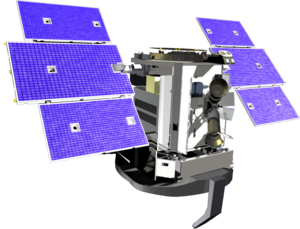
Back CloudSat Catalan Cloudsat Danish CloudSat German CloudSat Spanish کلودست Persian CloudSat French CloudSat Galician קלאודסאט HE CloudSat Hungarian CloudSat ID
 Artist's Concept of CloudSat | |
| Mission type | Atmospheric research |
|---|---|
| Operator | NASA |
| COSPAR ID | 2006-016A |
| SATCAT no. | 29107 |
| Website | CloudSat home page |
| Mission duration | Planned: 22 months Final: 17 years, 11 months, 25 days |
| Spacecraft properties | |
| Bus | BCP-2000 |
| Manufacturer | Ball Aerospace |
| Launch mass | 700 kg (1,543 lb) |
| Dimensions | 2.54 × 2.03 × 2.29 m (8.3 × 6.7 × 7.5 ft) (H × L × W) |
| Start of mission | |
| Launch date | April 28, 2006, 10:02:16 UTC |
| Rocket | Delta II 7420-10C |
| Launch site | Vandenberg, SLC-2W |
| End of mission | |
| Disposal | Passivated |
| Deactivated | December 15, 2023, 2:24:30 UTC |
| Last contact | 23 April 2024 (Decommissioned) |
| Orbital parameters | |
| Reference system | Geocentric |
| Regime | LEO |
| Semi-major axis | 7,080.59 km (4,399.67 mi) |
| Eccentricity | 0.0000824 |
| Perigee altitude | 709 km (441 mi) |
| Apogee altitude | 710 km (440 mi) |
| Inclination | 98.23 degrees |
| Period | 98.83 minutes |
| RAAN | 330.82 degrees |
| Argument of perigee | 91.62 degrees |
| Mean anomaly | 14.57 degrees |
| Mean motion | 14.57 |
| Epoch | 25 January 2015, 03:10:38 UTC[1] |
| Revolution no. | 46,515 |
CloudSat is a Passivated NASA Earth observation satellite, which was launched on a Delta II rocket on April 28, 2006, and is awaiting disposal. It used radar to measure the altitude and properties of clouds, adding to the information on the relationship between clouds and climate to help resolve questions about global warming.[2]
It operated in daytime-only operations from 2011 to 2023 due to battery malfunction, requiring sunlight to power the radar. On December 20, 2023, the Cloud Profiling Radar was deactivated for the final time, ending the data collection portion of the mission.
The mission was selected under NASA's Earth System Science Pathfinder program in 1999. Ball Aerospace & Technologies Corp. in Boulder, Colorado, designed and built the spacecraft.
CloudSat's primary mission was scheduled to continue for 22 months to allow more than one seasonal cycle to be observed.
- ^ "CLOUDSAT Satellite details 2006-016A NORAD 29107". N2YO. 25 January 2015. Retrieved 25 January 2015.
- ^ Stephens, Graeme L.; Vane, Deborah G.; Boain, Ronald J.; Mace, Gerald G.; Sassen, Kenneth; Wang, Zhien; Illingworth, Anthony J.; O'connor, Ewan J.; Rossow, William B.; Durden, Stephen L.; Miller, Steven D.; Austin, Richard T.; Benedetti, Angela; Mitrescu, Cristian (2002). "THE CLOUDSAT MISSION AND THE A-TRAIN: A New Dimension of Space-Based Observations of Clouds and Precipitation". Bulletin of the American Meteorological Society. 83 (12): 1771–1790. doi:10.1175/BAMS-83-12-1771. ISSN 0003-0007.
